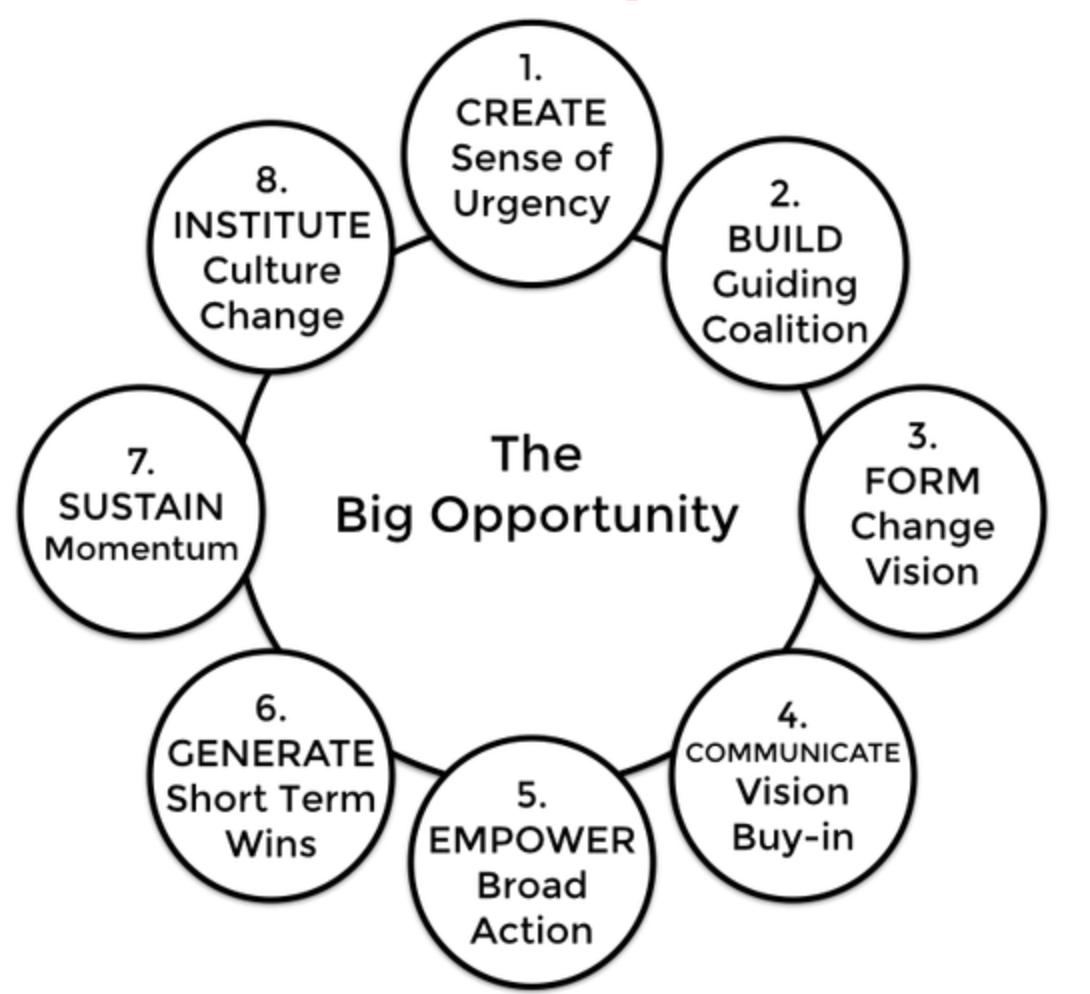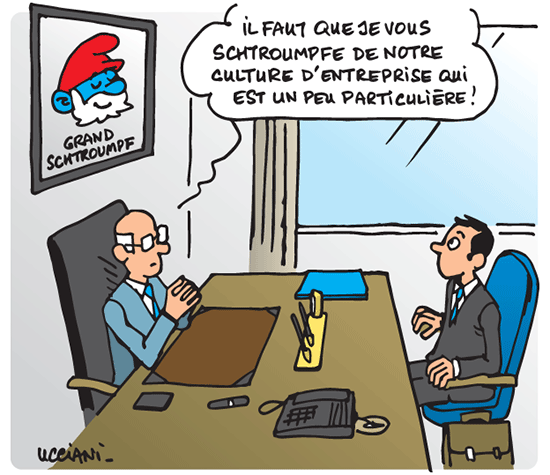How to leverage User Experience (UX) using Kotter's model, a deep organizational change model?
Integrating the concept of customer-centric actions into a business is not just about proclaiming that you are focused on the customer experience. It's about changing your process, but not only: you also have to change mentalities. You have to make your customers a central organizational value, which guides behaviors and decision-making.
Valuing the customer experience is no longer the secret to success. Focusing on the customer experience has quickly become the way of doing business. A problem identified by many customer experience (and user experience) professionals is that they are asked to "do customer experience" within a company that does not change its processes or its way of thinking. A lot of companies maintain the same strategic processes and approaches, while trying to “base” on this thing of customer experience.

Act rather than talk
Companies that adopt one thing while behaving differently can create various internal problems. These companies have an authenticity problem. They are less credible, both in the eyes of their employees and those of their customers. There can also be confusion about everyone's roles and responsibilities, which can lead to disengaged teams, creating an environment where employee confidence, focus and morale suffer – all resulting from a lack of commitment to an adopted/imposed value.
It seems obvious that companies are more efficient when there is an alignment between what they say they do and what they actually do. The real question is how do you create this alignment? What steps can a company take to really take action and focus on the customer experience?
Align what you do with what you say
I'm often asked what needs to be in place to get a company to value the customer experience. Becoming a customer-centric company may seem like an easy change, but there are many consequences to be aware of. Breaking away from old attitudes and our usual processes is difficult. This requires the integration of new mentalities, focused on the customer, but also and above all an organizational change.
Some may disagree with me, saying “it is always possible to have a positive impact on a customer's experience without seismic organizational change. " It's true ; it is possible – but only to a certain degree. Most of the time, you're going to find yourself at an impasse, or faced with a business unit that doesn't hold the same values, and there you'll be stuck.
Customer experience and organizational change
Organizational change is based on understanding existing problems and modifying business structures and processes. If you've worked in a software company for the past 10 years, you're probably familiar with these issues. For many reasons, you have surely seen the execution of an organizational change done incorrectly.
A common reason I see for organizational "change" efforts to fail is that there are too many change efforts being initiated at once: "Let's move to an agile development process, let's create a team of user experience, and let's start working towards continuous integration! »
These are very good ideas for things to change, but it is very difficult to carry out projects in several areas simultaneously. Change is disruptive and it is essential that the effort be thoughtful in its approach, and properly managed.
Change is not easy
More and more teams specializing in customer experience exist, which is generating awareness in many companies. However, many customer experience teams that I have encountered (and worked with) belong to just another business unit within a larger, and unfortunately dysfunctional, system. Adding a new business unit to a multitude of units that are already struggling to work together, adding overlap and gray areas regarding everyone's responsibilities, is likely to create more problems than solutions.
User experience professionals need to work successfully across all departments of the same company. Too often, these teams walk into dysfunctional systems and then become arbiters: they help product teams understand engineering; they help engineering integrate business and stakeholder needs; they help translate and share a vision that could be described as “organizational” within the different teams. And of course, all of these things take a lot of CX teams time, creating a dysfunctional environment.
So how can we get broader team engagement and collaboration for a more holistic approach to customer experience?
Using Kotter's Model for Organizational Change
John Kotter graduated from MIT. He is also an author, who teaches at Harvard Business School. Kotter's model, an 8-step process, is a model for companies looking for a way to organize lasting change. Depending on the size of the business, each step requires more or less effort, and each business should modify the approach to best suit their needs.

A few things to consider before getting started
In reality, you will not always be able to have access to all the elements of the company right away. However, that shouldn't stop you from getting a good look.
- Think the business globally, look beyond your own point of view.
- Review all elements of the change model, even if you don't plan to perform every step.
- At each stage, keep in mind the victories already achieved.
- Be aware that the model is presented as linear: there are cases where it can be more or less iterative – it will sometimes be necessary to go back to the previous steps in order to ensure quality, consistency and reliability, before going from the front.
Step 1: Establish a sense of urgency
To do this, you must ensure that your employees have instinctive reactions, by appealing to emotion, so that they have the desire to go further, and to win. Kotter talks about three types of urgency: self-indulgent, false, and true emergencies.
- The complacent urgency appears when things are going “good”. You're a leader in your market, and even though you know you should always improve your approach to customer experience, you're not doing much about it.
- The False Urgency occurs when everyone seems to be working very hard on improving the customer experience, when the reality is different. Surely you have experienced this before, in fast-paced environments where tons of meetings take place to discuss customer needs, yet with very little change and little action taken. In reality, this type of hectic work environment often leads to a waste of the work force.
- The real emergency can be defined by the positioning of your business. From customer service to engineering, everyone works to improve the customer experience and recognizes that everyone plays a vital role in the overall customer experience.
Step 2: Create a coalition team
Building a group with enough power to drive change is key. It's common to see directors or vice presidents in CX leadership positions, regardless of company size. An even greater interdisciplinary effort is needed to achieve lasting change.

In creating a coalition team, Kotter recommends three key aspects:
- positional power : In other words, you need influencers to help you get things done, and to ensure that the effort is successful from start to finish. You need the right people to lead the way and achieve the goal.
- Expertise : This is Kotter's way of saying that all points of view need to be represented. This team cannot include only Top Management, only engineers, or three representative business units when the company has a dozen or more different teams or disciplines.
- Credibility : This is a difficult point – the name of the team alone does not guarantee credibility. Who is respected throughout the company? Who inspires others and generates trust? Whoever these people are, it is necessary to involve them.
Step 3: Develop a vision for change
Demonstrate that the future will be different from the past. This is a crucial step: creating a clear, motivating, and coordinated vision that serves as a guiding principle for change.
Kotter lists six key points for success:
- Imaginable : Create a simple and clear picture of the future.
- Desirable : Appeal to the long-term interests of those who have a stake in the business.
- Feasible : Make sure the vision is realistic. Achieving revenue rivaling Amazon or Apple in the next 12 months might not be achievable for your startup.
- focused : Having a clear vision of the objectives requires decisions to be made as we go along. A vision focused on a specific goal facilitates and distributes decision-making.
- Flexible : The fact that a goal is fixed does not mean that it cannot be flexible. Good visions can incorporate changing conditions. Be careful though, flexibility should not lead to an undisciplined approach.
- transmittable : Confusing terminology only complicates matters. All employees must be able to understand and successfully share the company's approach to customer experience.
Step 4: Encourage teams to buy in to the vision by communicating

It is necessary to ensure that as many people as possible understand and accept the new perspective of the company. This step is very similar to the previous one, but depending on the structural complexity of your business, it can be more or less difficult. Think about your communication channels: Do you have a regular newsletter, or a company portal? What do you think of physical locations, such as billboards, to display this vision? What about communication to the different divisions of the company?
Here are four criteria that must be met by the communication relating to the vision:
- Simple : It is necessary to avoid technical talk, or jargon specific to the discipline. It's a much bigger problem than you think. I have witnessed UX and CX teams struggling because few people within the company were able to understand what “cognitive load” was. What sometimes seems “simple” can turn out to be difficult for other populations.
- Vif : Bulleted lists have a limit, and therefore are not sufficient. Can you imagine the vision? Metaphors and analogies, when appropriate, are great ways to help everyone connect with the vision.
- Reproducible : The concepts of the CX vision should be easy to repeat for everyone within the company. Everybody. Without exception.
- Open to suggestions : Communication should not sound like a decree from management. It's a vision that should be treated as a two-way conversation within your company.
Step 5: Promote diverse action
It is also essential to minimize the barriers that employees may face, and encourage them to do their best. The freedom to make the right decisions and having sufficient leeway with respect to organizational barriers is the key to success. The idea behind Step 2 (Building a coalition team) is to ensure that diverse action is possible. Poor communication between the various management bodies as well as disproportionate managerial restrictions undermine the quality work that employees are able to offer. So remove layers, synchronize activities, and simplify structures.
Step 6: Generate short-term gains
We must create visible, unequivocal success as soon as possible. Planning pays off here. If your team takes a long time to deliver results, in any scenario, business confidence will begin to falter. Let's be honest, short-term gains also help silence enemies, including those who believe the only path to success is the one they've created. Help them understand that this is not necessarily the case through short-term wins, earned early and often.
Step 7: Never let go
Consolidate gains, and produce more change. At the end of the day, we talk about changing behavior and changing mindsets. This requires employee commitment and discipline. One success can lead to another success and yet another, but ceasing to rest on its first successes leads the company to lose sight of its long-term vision. Customers will continue to use your product or service, so you can't afford to slack off on understanding and designing their experience.
Regular visits with the coalition team can help ensure that successes can be repeated and that you understand why failures have occurred. There will be failures, but they are only harmful if we don't learn from them. Share your successes within teams and show that you are continually paying attention to reducing cross-team dependencies.
Step 8: Adapt your corporate culture
Anchor new approaches in corporate culture to achieve lasting change. Change is not easy. For a change effort to be successful, it takes intentional and sustained effort. As I mentioned before, we seek to change behaviors, and in fact, this corporate culture directly impacts behaviors. In other words, your organizational change efforts are successful when they become embedded in the organizational culture.
Kotter reminds us of the fundamental rules around culture change:

- The proof wins : The “new” way must turn out to be better than the old one.
- Visibility : Ensuring that everyone associated with the change process sees and fully understands the successes.
- people will leave : When real change happens, some people feel uncomfortable and prefer to leave. It's always difficult, but it's an unavoidable reality.
- Reinforcing new standards : Reinforce the new norms and this new culture with both experienced and new employees, using incentives, rewards and promotions – whatever you feel is most appropriate for your business.
Be realistic and maintain your will to change
Kotter's model makes great points, and prescribes a deliberate and purposeful strategy for achieving organizational change. Think about how you can adapt this model to your business so that it is effective. And when it comes time to use this model, consider how it can be applied to your customer experience change effort—either broadly across the enterprise, or more targeted.
It is also important to recognize that each application of the model may be a little different depending on the company. Above all, it is necessary to be respectful towards your whole company when you decide to change something. Finally, being realistic about how change efforts should be approached within your company, holistically, is the first step to real and lasting change.
Translation : Item No. 1359 | December 16, 2014 | Pete Kinser
Isabelle De Carvalho, UX-Humanist @UXRepublic
STORYTELLING: THE ART OF CONVINCING # Paris
SMILE Paris
163 quay of Doctor Dervaux 92600 Asnières-sur-Seine
UX/UI ECO-DESIGN # Paris
SMILE Paris
163 quay of Doctor Dervaux 92600 Asnières-sur-Seine
DESIGN THINKING: CREATING INNOVATION # Belgium
UX-REPUBLIC Belgium
12 avenue de Broqueville - 1150 Woluwe-Saint-Pierre
MANAGING AND MEASURING UX # Paris
SMILE Paris
163 quay of Doctor Dervaux 92600 Asnières-sur-Seine
DESIGN SPRINT: INITIATION & FACILITATION # Paris
SMILE Paris
163 quay of Doctor Dervaux 92600 Asnières-sur-Seine
UX-DESIGN: THE FUNDAMENTALS # Belgium
UX-REPUBLIC Belgium
12 avenue de Broqueville - 1150 Woluwe-Saint-Pierre
GOOGLE ANALYTICS 4 #Paris
SMILE Paris
163 quay of Doctor Dervaux 92600 Asnières-sur-Seine
ACCESSIBLE UX/UI DESIGN # Belgium
UX-REPUBLIC Belgium
12 avenue de Broqueville - 1150 Woluwe-Saint-Pierre












